Shutter speed, Khao Kheow Open Zoo

|
• Celadon Hotel • Duy Tan Hotel • Festival Hue Hotel • Heritage Hotel Hue |
Feature Photograph
This week's photos are not necessarily wonderful technically correct photographs, but instead bring with them special significance which makes them worthy of being a Featured Photograph on merits other than being a pretty picture. Both of these photographs were taken about eight years ago, and captured with a very basic digital compact camera. In both cases I didn’t even recognize the significance of the photographs until months later.

The above photograph I captured north of Chiang Rai during the rice harvest. I was spending time in the countryside getting to know more about the local farmers, how they lived, how the business of rice farming worked, and about their backgrounds. During one stop I came across two elderly ladies who owned what looked to be about 20 rai of land, most of it rice paddies with a modest home centered on the land. I was amazed and filled with admiration when I learned these two ladies took care of the place themselves and did 100% of the work. I asked the question “how did you become friends?” I flipped on my tape recorder and listened to her talk on in a mixture of Thai and Lao which I could barely understand. My assistant was helping to translate my questions. I remember how serious she was, and how some of her explanation looked painful for her to recount. My assistant looked sad, both ladies looked sad, and I was mostly clueless.
Some months later I was working on something where I wanted to find and interview victims of sexual slavery. My assistant told me she thought the lady we interviewed north of Chiang Mai would be a good feature. I was taken aback, I had no idea this is what they were talking about. I’d finished that particular project and closed it before I got to her transcripts which is often the case. My assistant pulled out the transcripts so I could read along while she told me the story.
“Do you notice how her wrist is deformed in the photograph?” She goes on to tell me that as a young teenager she was taken from the street and found herself chained to a steel framed bed in a room with others. She was forced to service customers many times a day. This treatment went on for many years and many of the ladies held captive in the same place died, none were released. Some were traded, she was traded herself several times. The lady she now lives and farms with was also a victim and they became friends and managed to stay together. Finally, when they were too old to be of value to customers they served some years cleaning and cooking, and then were released during some event I still don’t understand. They applied for a program to get land and grow rice, and have worked hard for years building their small rice farm.

I’ve been to the floating market with friends, family, and clients almost 50 times. In all the times I’ve been, and the thousands of pictures I’ve taken, this one taken with a simple digital compact camera remains my favorite. It provides a feeling I’ve been unable to duplicate in the eight years since.
Weekly Photo Outing
This week we visit the Khao Kheow Open Zoo in Chonburi, about 15 minutes outside of Pattaya. Another website is here.
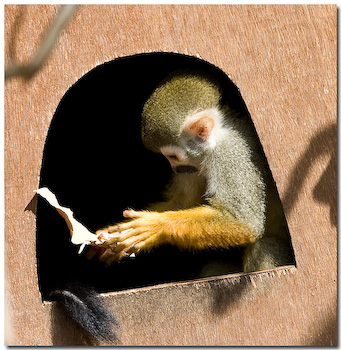
I enjoy this zoo for several reasons. It’s close to Pattaya, The Sanctuary of Truth, and The Tiger Zoo, so it’s easy to plan a day trip where you visit all three. You could easily spend 2-3 days at each location, but it makes for a dynamic and interesting outing to visit all three in the same day. While the Khao Kheow Open Zoo is very large, only a small part of it will be of keen interest to photographers. These will be the areas where you can photograph animals without some sort of barrier between you and the animal. This is why I’m fond of the Siracha Tiger Zoo. It’s the only place I know of to photograph tigers at play without heavy glass, plastic, or some sort of fencing getting in the way.
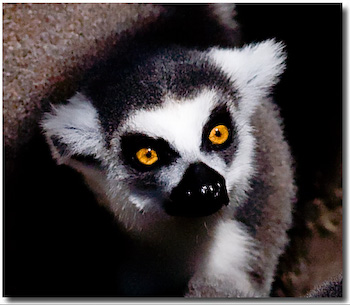
The entrance fee is 100 baht for foreigners. For local expats, I’ve found that at many of these zoos, national parks, and the such where they charge more for a foreigner, if you have a work permit or some form of permanent residency proof, you can ask to be charged the local rate. My assistant shows them my Thai driver's license and explains I live in Thailand, and I get charged the local rate. This has worked at the Grand Palace, Ko Samet, Tiger Zoo, Open Zoo, Sanctuary of Truth, and many other places.
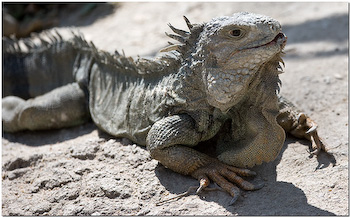
Khao Kheow Open Zoo in unique in that you can drive your car from exhibit to exhibit, parking is always available. If you’re a photographer carrying lots of equipment this is especially nice as you can park at an exhibit, take note of which lens and gear you’ll want, and only take what you need from the car. When you finish at on exhibit you drive to the next one. There are also trams which can take you around on tour.
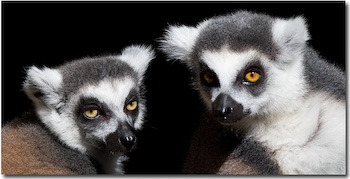
I especially like the Lemurs and monkeys. Not long ago there were at least a dozen new lemur babies which were a lot of fun to photograph. There are many different monkey and ape species with only a moat separating you from their habitat. The distance for most of these exhibits is perfect for a 300mm lens, and often a 500mm lens will allow you to get very close and personal. 70 – 200mm lenses are also very popular for capturing the animals along with a part of their habitat.
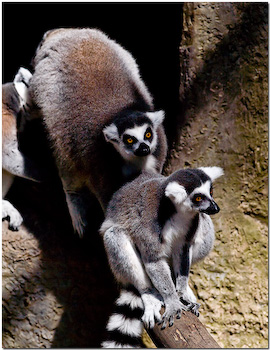
Shutter Speed
In our quest to understand the basic variable settings of a camera we’ve so far covered ISO and Aperture. Today we’ll cover Shutter Speed. Next week will be Focal Length followed by Focal Distance. Once we’ve covered these five variables and have a basic concept of what they are and how we adjust them, then we can use these variables to create all kinds of exciting compositions. Hang with me a few more weeks and we’ll start putting all this together.
A shutter is nothing more than a device to let light in and out. On a pinhole camera described last week, a basic wooden box with a pin hole for a lens, you finger becomes the shutter as you move it over the hole, and away from the hole. More recently we had 100% mechanical shutters. When I say 100% mechanical, I’m talking about not only the physical part that moves to let light in and out, but also the device part that sets the speed and timing of it moving in and out.
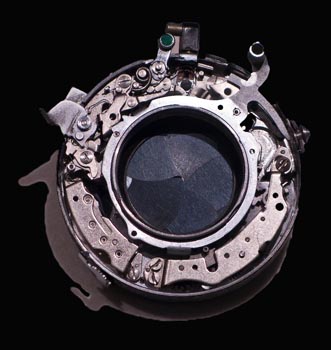
In film SLRs we traditionally had leaf shutters. The “leafs” were most often made of a dark fabric, but could also be made from strips of stainless steel and other special metals. Remember putting film in your 35mm SLR? The full spool went to the left side, you pulled out a strip of film and then fed it through the take up reel on the right side? In the middle, that rectangular black thing you laid the film over? That was a leaf shutter with a fabric curtain. The curtain merely moves horizontally from side to side. Watching the curtain move in real time is interesting, it looks like a piece of fabric very quickly slides from left to right.
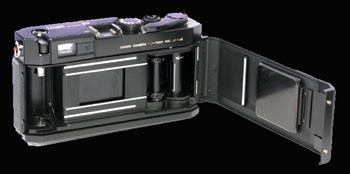
Today’s cheapest compact point and shoots sometimes have 100% electronic shutters. All these do is turn the sensor on and off for the desired time/speed. These work with our camera phones and cheaper P&S’s, but function and image quality suffers in ways obvious to a more advanced level of photography, but not so obvious to the casual user.
Modern digital SLRs (DSLRs) have combination mechanical/electronic shutters. The mechanical parts are the steel leaf blades that move up/down like a window shutter, and the electronic part is what controls the timing of how long the shutter remains open. These shutters are modern marvels. On the professional cameras like the Nikon D3 and Canon 1D series, the shutters are rated for at least 150,000 actuations. This would last an amateur a life time. They also move at up to 11 frames per second which is lightening fast for a mechanical mechanism. These are some really tough and special shutter mechanisms. Below, are the shutter assembles for the Nikon D3 and Canon 1dsMarkII respectively.
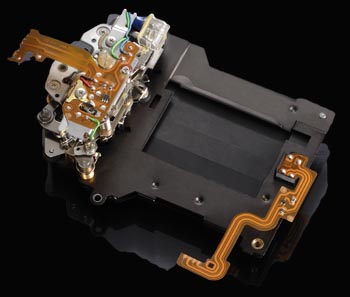
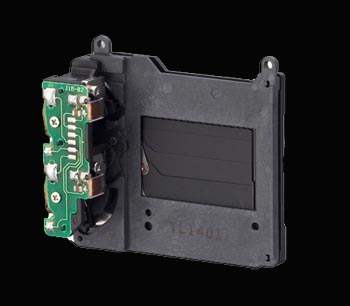
How long we leave the shutter open affects exposure. The longer we leave it open, the more light hits and is gathered by the sensor. Also, the longer we leave it open, the more chance we’ll get “camera shake” resulting in a blurred image. When we open and close the shutter very fast, it allows us to freeze objects like balls in the air, butterfly wings, and all sorts of sporting events. Recently in the Olympics a high speed camera was able to verify Michael Phelps won the 100 meter butterfly by a mere 1/100th of a second. This is way too fast for the human eye to see, and if it wasn’t for the excellent Omega timing system and high speed cameras, the call would have been up to some official and argued about for years and we’d never really know who won.
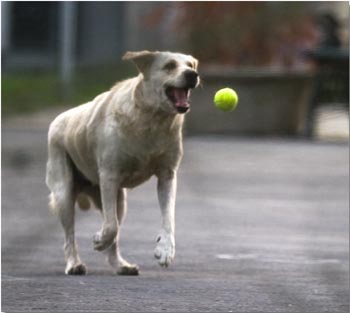
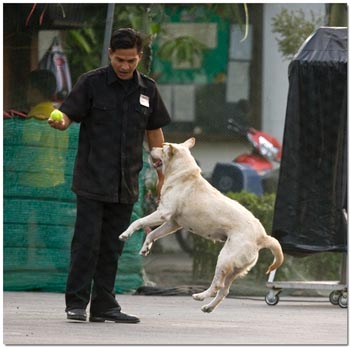
Shutter speed is measured in seconds. Like aperture, we also talk about shutter speed in “stops.” Remember, a stop is either double the previous value, or half the previous value. A shutter speed of 1/1000th reduced one stop is 1/500th. 1/500th reduced two stops is 1/125th. Reduced four more stops 1/8th. Once you get in the habit of talking about shutter speed, aperture, and ISO in “stops”, then it becomes very easy to understand how they work in relation to each other, and how when we change one “one stop”, it affects the other “one stop.” We’ll have plenty of examples of this in future columns.
What shutter speed to use? It really depends. It depends on available light, if the subjects are moving, the focal length of the lens, the aperture selected, and the ISO. The “Basic Rule” and a good starting point, is that shutter speed should be 1/(focal length) So, a 50mm standard lens should require a 1/50th shutter speed. A 24mm lens should require a 1/24th shutter speed, and a 300mm lens should require a 1/300th shutter speed. This is a starting point only, a general rule of thumb. There are many reasons you’d select a speed either faster or slower, reasons we’ll cover later. For now, just understand what a shutter is, that the length of time it’s open is measured in seconds or stops, and that if we leave the shutter open too long we’ll get blurred images, and if we open and close it really fast we can freeze action.
Photography News of Interest
Photokina happens in about 17 days. Camera manufacturers have already begun announcing new products and will continue to do so until the big day, saving their most important announcements for the show itself.
Nikon recently announced a new consumer level DSLR called the D90. This camera is significant because it’s the first ever DSLR with a movie mode, and a HD movie mode to boot! With it’s HDMI television output you’ll be able to capture HD movies and then watch them on your television simply by connecting a HDMI cable between the two. It also captures 12mp still images which is the purpose of a DSLR. You can read a hands on review here.
Other announced products include a new Nikon AF-S DX 18-105mm lens, a Sony compact Cyber-shot DSC-T500, a screaming fast 30mbps SD flash memory card from SanDisk, and Tamron has announced a trio of new lenses for Canon and Nikon crop sensor cameras.
The National Forum of Photojournalists (NFPJ) organized a rally to mark the 169th World Photography Day.
Readers' Submissions
Hi Bkk,
Here are a few photos of the Chiang Mai flower festival at either the end of 2006 or the beginning of 2007. The camera that I used was a Canon Powershot S2 IS. I'm trying to stop using the automatic settings to be a bit more creative, your site is ideal for me because it's easy to understand the explanations & the Thailand Asian angle keeps me interested. Keep up the good work.
Regards
Khunklit

|

|

|

|
Khunkit
Thank you. These are really nice! Khunkit sent me full size images where you can really see all the detail and people.
Thanks for the submissions!
BKK Steve
I suspect the readers' submissions will be a highly anticipated section of this column and I encourage anyone with photographs and travel accounts they’d like to share to please send them to me at: QandA@Bkkimages.com
Readers' Questions
Hi there
Just wondering what your opinion is on buying a camera in Thailand or in my home country Canada. I have found that any camera I have taken to Thailand with me tends to seize up or stop functioning properly. When I call tech support the companies tell me they believe it is humidity. Just wondering if buying a camera in Thailand would reduce my chances of having this type of problem or am I just having bad luck. By the way the same thing has happened to cell phones I have taken with me.
J-M
J-M, this is a really good questions with a simple answer that I hope doesn’t disappoint you.
Camera models remain consistent no matter what country they’re sold in, with the exceptions of input voltages on battery chargers to meet local power standards, and sometimes whether or not the TV output is in PAL or NTSC. Over the last few years most digital cameras come with universal voltage chargers and selectable PAL/NTSC as more people travel with their digital cameras than ever before. Even the instruction manuals come in 5-6 languages in the same booklet. A Fuji F100 manufactured for instance in Malaysia, will get shipped all over the world to all the different markets, with very small things like the language on the box, the included languages in the instruction booklet, and the plug type in the chargers being different.
Does this mean you’re just having bad luck? I suppose it’s possible, but I think there might be a different explanation. Condensation. Many people don’t realize the possible short and long term damage caused by condensation which occurs as you take a electronic device from an air-conditioned low humidity environment, to a hot and humid outdoor environment. The damage can be enough to cause the rare instant failure, but often just leaves enough water inside the camera on it’s electronic components to cause a long term corrosion. One day enough corrosion happens and the camera fails in some way.
What can we do to negate condensation as we travel? Old fashioned silca gel packs in our camera bags work, but be sure to replace them every so often. The big thing is to be very careful when bringing out cameras from a cold to hot environment, like coming our of your hotel. It would be best to have the camera in a small bag with limited air around it, and let it warm up slowly before using it. About 15 minutes should work fine. I’d avoid carrying it around your neck on a strap totally exposed to the environment as you transit a cold to hot environment. I’ve said before that I carry ziplock bags as a matter of habit when I travel? These are great for preventing condensation damage. Once my bag has been out in the car or heat for about 15 minutes, the temperatures have equalized, and I’m ready to use the camera.
I hope this helps.
Hi Steve
Thanks for the great weekly series on Stickman's site. I am really enjoying it. My question is: I am coming to BKK in October and am wondering if purchasing legitimate copies of Lightroom 2, Nikon Capture FX 2 and Photoshop CS2 is cheaper in Thailand than in the west? If I do purchase them will I be able to install them on my computer in English or will I need to know Thai. And can you recommend any shops to purchase them from?
Many thanks
Jeremy
I’m glad you specified “legitimate” because we all know pirated software is readily available in places like Panthip Plaza and MBK. Because my livelihood depends on copyright enforcement, and because I get a lot of use from my software, I always purchase licensed software. Pirated copies can also be problematic, as new cameras and devices come out all the time and if they’re not supported by the copy of pirated software you picked up at Panthip last year, then what? Licensed copies allow you to obtain free updates and support. This is really the way to go.
You’ve mentioned some really nice software and I’m familiar with it all. In fact, I own current licenses on everything you mentioned. This is what I’ve learned about the prices of software and even cameras and electronic equipment in general. Thailand, like Britain and the rest of the EU charges quite a bit of tax on imported products. Everything you mention is imported. Two out of the three products you mentioned are from US based companies. Because of the taxes and import duties, I buy almost all of my software, cameras, computers, and other electronics in the US when I can. It’s the largest single market in the world, it’s taxed less than anywhere else I’m aware of and the savings can be huge. It’s very common for Europeans to take “buying vacations” in NYC, flying into New York and having a great time shopping at the many pro level camera stores like B&H and Adorama. I’ve been told on average, they save more than enough to pay for their flight, room, and other expenses and they have a great time in the process.
Software however can often be purchased on-line. Adobe products can for certain. When you log into such a site it reads your ISP and assumes you want to pay and ship in the currency where your ISP is located. If I log in from Thailand they assume I want the product shipped to Thailand and will pay in Thai baht. Because I have credit cards in the US, I can pay the US price and choose their download service vs. actual delivery. This saves me a significant amount over local purchases in Thailand. It would save me much more over local purchases in the EU. I’ve made it a point to apply for and be issued visa cards from the US, Thailand, and the EU. They often come in handy.
I hope this helps.
Please submit your questions to QandA@Bkkimages.com. All questions will be answered and most will show up in the weekly column.
A Snapshot of Bangkok Images Week in Review
This has been a good week. We continue to improve our website but it’s almost done with the exception of the galleries we’ll be adding.
We did a consultation for a company building a website and will be doing the photography portion. I’ll be covering a orchestra and choir performance for the princess and other royal family members tomorrow and will share some of that with you next week. And I have a client coming in this weekend for a week long workshop starting Monday. Busy season is nearing.
Mirrored Blog
I haven’t had time to address my blog issue yet, and I could still use some help from anyone who really knows WordPress. Hopefully I’ll get the blog back up by next week.



